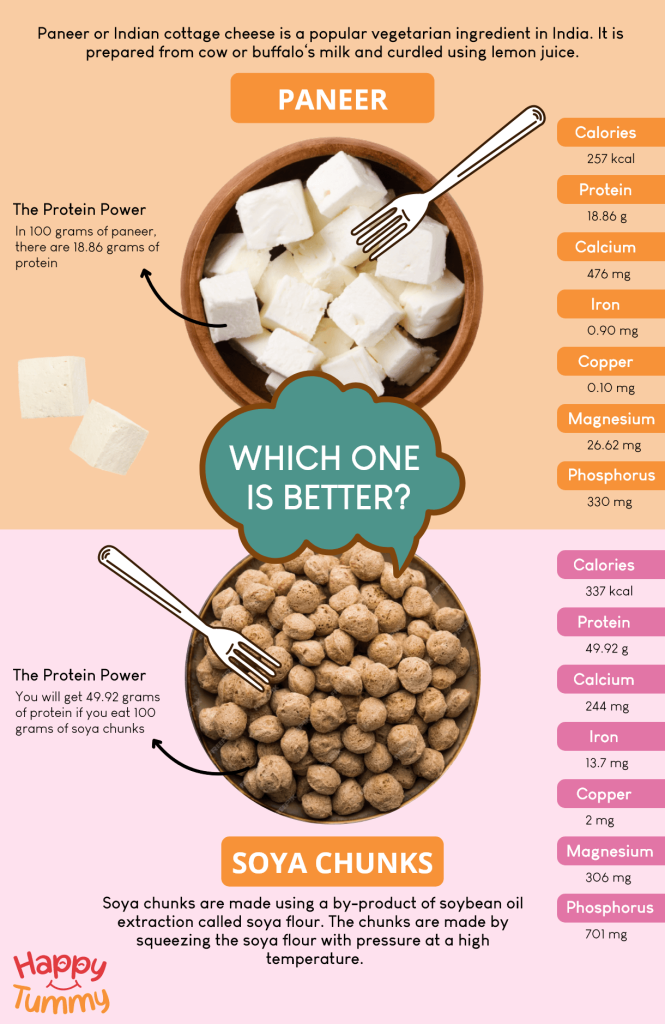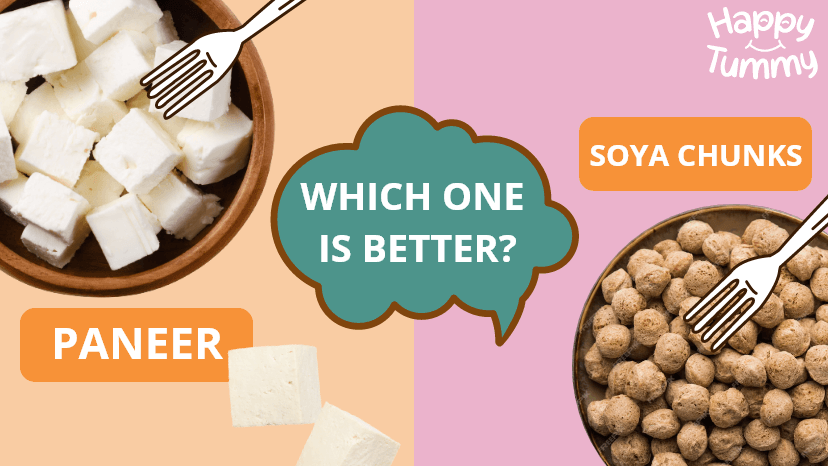Table of Contents
Which source has the highest protein? This is a very common question that is often asked, especially if you are wondering about the protein source for vegetarians.
Paneer and soya chunks are two favourite ingredients that consistently top the chart when protein comes into the picture.
Soya chunks, which come from soybeans, are a favourite among health enthusiasts because of their low fat and high protein content.
Indian cottage cheese, or paneer, is praised for having a high calcium content and a thick, creamy texture.
Let’s look at both of these ingredients and find out which one is better and why.
What is Paneer?
Paneer or Indian cottage cheese is a popular vegetarian ingredient in India. It is prepared from cow or buffalo’s milk and curdled using lemon juice.
There are a lot of Indian dishes that can be made using paneer, such as palak paneer, paneer bhurji, or paneer parantha using Aashirvaad atta with multigrain.
Also Read – Health benefits of eating paneer
What are Soya Chunks?
Soya chunks are made using a by-product of soybean oil extraction called soya flour. The chunks are made by squeezing the soya flour with pressure at a high temperature.
This is also an excellent ingredient for vegetarians in India, and several dishes, like soya chunk biryani, soya aloo sabzi, or chilli soya chunks, can be made.
Also Read – Health benefits of soya chunks
Nutritional Profile of Soya Chunks and Paneer
Let’s look at other nutrients present in both these super ingredients in 100 grams:
| Nutrients | Soya Chunks [5] | Paneer [6] |
| Calories | 337 kcal | 257 kcal |
| Protein | 49.92 g | 18.86 g |
| Calcium | 244 mg | 476 mg |
| Iron | 13.7 mg | 0.90 mg |
| Copper | 2 mg | 0.10 mg |
| Magnesium | 306 mg | 26.62 mg |
| Phosphorus | 701 mg | 330 mg |
| Potassium | 2490 mg | 63.53 mg |
Calorie Count – Soya Chunks vs Paneer
Calories play a vital role, especially if you are taking these ingredients for weight management purposes. Even though both are considered super healthy, do you know soya chunks have more calories than paneer?
Surprised, right? Yes, 100 grams of soya chunks have more calories than 100 grams of paneer. However, do you actually eat 100 grams of soya chunks at once? May not be.
That is why the calorie count depends on your serving.
Here is a quick comparison. When you prepare paneer sabzi for 2-3 people, you usually need approximately 100 grams or more of paneer.
On the other hand, you do not need to use 100 grams of soya packet to make soya sabzi for the same numbers of people.
Hence, the number of calories you consume by eating soya will be less. That is the reason soya is often considered light as it fluffs and makes you full, with fewer calories.
So, what is the calorie count in both of them?
In 100 grams of paneer, you get 257 kcal [1], whereas in 100 grams of soya chunks, there are 337 kcal [2].
But what about protein? Eating less amount will also mean getting less protein. Let’s find that out.
The Protein Power

Protein is an essential component of your balanced diet. Your body needs protein daily to keep the bones, skin, and muscles fit, fine, and healthy.
Generally, people talk about consuming fish, eggs, and meat for protein intake. But the discussion for vegetarians is which one offers more protein – soya or paneer.
So, let’s find out which one has more protein.
In 100 grams of paneer, there are 18.86 grams [3] of protein, and you will get 49.92 grams of protein if you eat 100 grams of soya chunks [4].
However, since you eat less than 100 grams of soya in one go, the protein amount will decrease. This means that the protein you get from soya will depend on the quantity you consume.
Whereas, if you eat a paneer sabzi, you can easily consume 100 grams or so in one serving. Thus, they get more protein than soya chunks.
Besides calories and protein, these ingredients are highly rich in other nutrients, such as magnesium, phosphorus, potassium, iron, and calcium.
If you compare the values, it is evident that soya chunks have more nutritional value than paneer.
However, always remember that values for soya chunks are listed per 100 grams and you do not eat this much quantity in one go.
Therefore, suggesting which one will be better depends on your fitness and health goals and reasons.
Comparison Between Soya Chunks and Paneer
Here is a table comparing the benefits you can get from these two ingredients:
| Ideal For | Soya Chunks | Paneer |
| Heart health | Yes | No |
| Fighting inflammation | Yes | No |
| Controlling blood sugar levels | Yes | Yes |
| Helps in menopause | Yes | No |
| Healthy digestion | Yes | No |
| Weight loss | Yes | No |
| Builds Muscle | No | Yes |
| Bones and Teeth | No | Yes |
| Immunity | No | Yes |
| Brain health | No | Yes |
| Reduce stress and anxiety | No | Yes[l1] |
Some Recipes
Garlic Paneer Recipe
Try this amazing paneer recipe to include in your diet:
Ingredients:
- Paneer – 1 ¼ cup cubed
- Garlic – 6 cloves
- Vinegar – 1 teaspoon
- Red chillies – 5-6
- Sugar – 1 teaspoon
- Salt – per taste
- Oil – 2 tablespoons
- Cumin – ½ teaspoon
- Onions – ½ cup chopped
- Coriander leaves – 2 tablespoons for garnish
- Soya sauce – 1 teaspoon – optional
Method:
- In a blender, add chillies, garlic, salt, sugar, and vinegar and blend with 2-3 tablespoons of water.
- Heat a pan; add oil and cumin seeds.
- Once sizzle, add onions and saute on medium heat until golden brown.
- Add soya sauce and cook till oil separates.
- Adjust salt if needed, add paneer, and give a gentle mix.
- If too dry, add 2-4 tablespoons of water and saute for another 2-3 minutes.
- Garnish with coriander leaves and serve.
Soya Chunks Dry Recipe
Ingredients:
- Curry leaves – 1 spring
- Cumin seeds – ½ teaspoon
- Soya chunks – around 1 cup
- Tomatoes – 2
- Onion – 1 sliced
- Hing – 1 pinch
- Green chillies – 1-2 sliced
- Ginger garlic paste – 1 teaspoon
- Salt – per need
- Garam masala – ½ teaspoon
- Oil – 2 tablespoon
- Coriander leaves – to garnish
Method:
- Boil soya chunks in water for at least 5 minutes. Leave them in the water for some time. Rinse and squeeze excess water before using.
- Heat oil, add cumin seeds and curry leaves. Saute till cumin crackles.
- Marinate soya with ginger garlic paste, chilli powder, and garam masala and let it sit for at least 15 minutes.
- In the pan, add hing, onions, and green chillies and saute till transparent.
- Add tomatoes, turmeric and salt.
- Add soya chunks, mix, and cook covered for 5 minutes.
- Garnish with coriander leaves and serve.
Final Thoughts – Soya Chunks vs Paneer – Which One is Better?
Choosing between soya chunks and paneer depends on the end goal. If your end goal is to build muscles or hit your protein target without worrying about calories – paneer is your answer.
However, if you want to lose weight and feel full without adding too many calories – soya chunks might be the right option for you. Paneer, being higher in fat, should be consumed after expert advice if you have a goal of managing weight!
However, remember, both soya chunks and paneer have other essential nutrients as well. So, they both are superheroes that you may want to include in your diet.
If you want to know more about which one will suit you the best, reach out to the nutritionist at Aashirvaad.
FAQs
In 100 grams of soya chunks, you will find 49.92 grams of protein as compared to 18.86 grams of protein in 100 grams of paneer.
Soya chunks are high in calories when compared to paneer. In 100 grams, you will get 337 kcal of calories in soya and 257 kcal of calories in paneer.
Since weight loss requires less calorie intake, soya chunks make an excellent option. It is because even though the calorie content is high in them, you may eat less than 100 grams in one go. Thus, the calorie amount will depend on how much you consume.
The only thing people must consider before including them in their diet is allergies. If someone is soy allergic, they may want to avoid soya chunks, and if they are lactose intolerant, they may wish to prevent paneer.
Digestion varies on the individual digestive system. In general, paneer may be considered easy to digest as compared to soya chunks. To learn more about your digestive health, take Aashirvaad’s digestive quotient test.
















